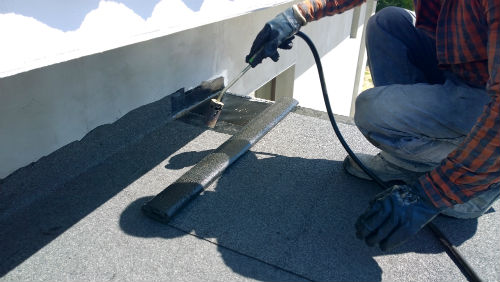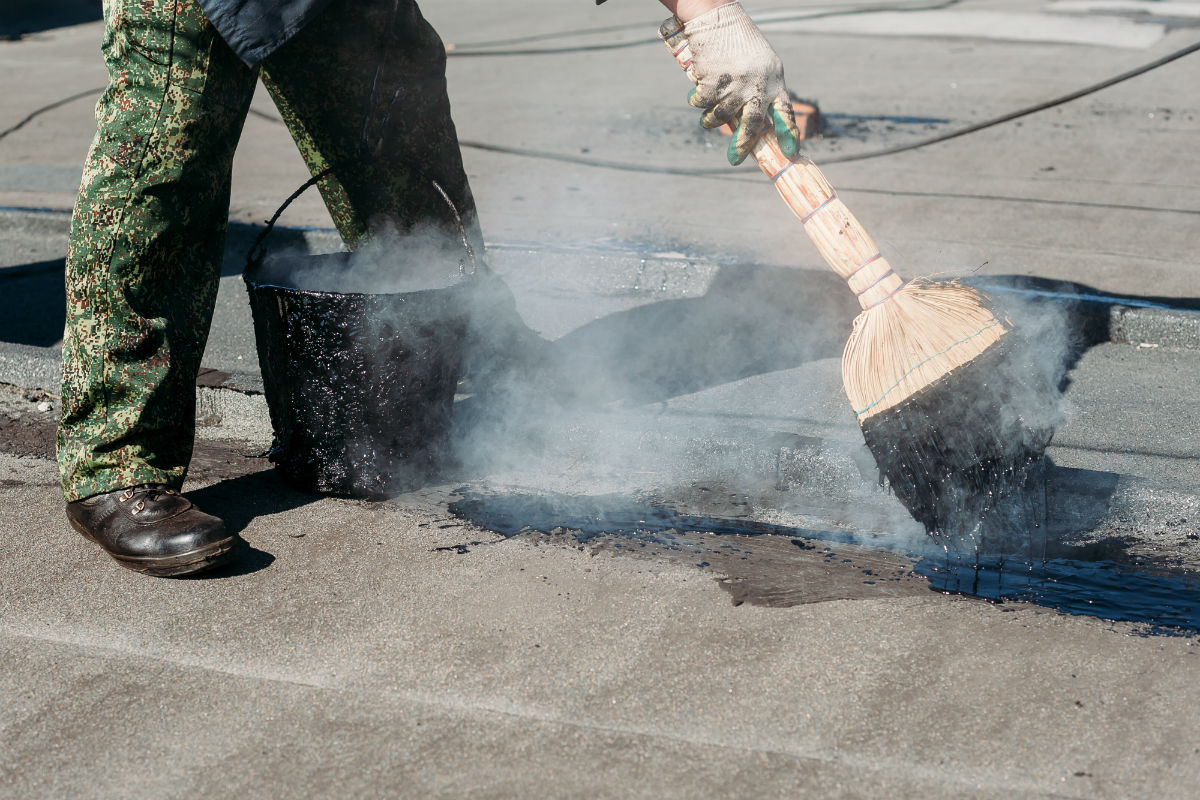Hot mop roofing is considered to be the most effective way of covering a flat or low-slope roof. The result is an impermeable, multi-layered roof covering that will last for up to 15 years—longer if the roof is laid with good drainage that avoids puddling.
One of the more affordable roofing solutions, it can be installed relatively quickly. However, it can be quite a messy and potentially hazardous job that really should be tackled by trained professionals.
The Hot Mop Process
One of the things that makes a hot mop roof affordable and a popular choice is that it can be applied on top of an existing roof—as long as the building structure can take the weight of the old and new roofs.
First of all, flashing is added around the edge of the roof, and around fittings and roof penetrations, to ensure a waterproof seal.
Once the existing surface has been tidied and reasonably cleaned, the roof is covered with a rosin paper or similar waterproof building material as the first layer. This is then covered with a hot liquid asphalt (heated to around 400 degrees Fahrenheit), which is applied with a large mop—hence the name of the process.

Building felt is then laid on the molten asphalt and the process repeated two or three times. The whole thing can take two to three hours to dry, before an optional top layer of stones and gravel can be applied, to add ballast, to stop the layers from bubbling, and to protect the roof against UV rays that can break down the upper membrane over time.
Advantages of Hot Mop Roofing
Hot mop roofing is an excellent choice for the following reasons:
- Well-proven technology. This method has been around for many years, albeit originally with coal tar rather than asphalt.
- Seamless and completely waterproof. Because the system involves the application of a hot liquid in several layers, there are no seams to leak. In fact, in very hot weather, the asphalt will significantly soften and self-seal any gaps or cracks that may have developed during the cold Colorado winter.
- Long-lasting. A hot mop (or built-up) roof should last for up to 15 years or even longer.
- Long warranty. Roof suppliers will offer a long warranty on a hot mop roof, due to its reliability and longevity.
- Quick and easy to apply. The technology is relatively straightforward, although should be left to the professionals.
Disadvantages of Hot Mop Roofing
As great as hot mop roofing is, it isn’t without its drawbacks. Some include:
- Can be quite messy. Most roofing suppliers will take necessary precautions to minimize spillage and splashes.
- Labor intensive. The process can require a team of technicians to apply and install the roof quickly and efficiently.
- Hazardous. There are very hot liquids involved, which have to be transferred from ground level to roof height. Therefore, it is not recommended as a DIY job, but best left to the professionals.
- Strong smelling. The hot liquid asphalt is strong smelling and toxic. The fumes can present problems for children, the elderly, and people with respiratory conditions such as asthma. This means that a property being re-roofed is best vacated during installation, which can prove to be inconvenient.
Repairing a Hot Mop Roof
The recommendation is most definitely to have your hot mop roof installed by a professionally qualified team, working for a reputable roof supplier, such as A-to-Z Roofing. It’s potentially dangerous and messy.
However, if you do find yourself with a problem that needs repairing, you can make local repairs if you feel confident and capable, and you have all the tools you need.
The first and very important thing you must do is to be absolutely sure that you have a built-up asphalt hot mop roof and not a single membrane roof. Ask colleagues or find original paperwork, just to be certain. Once you have established that, you’re set to go.
The process, basically, involves the application of a series of increasingly sized fabric patches over the damaged part of the roof, which are applied using an asphalt-based adhesive.
Most importantly, since you will be adhering the first patch to the top layer of the roof, it is vital to ensure that all gravel is removed around the point of damage, and the area thoroughly cleaned. After applying two layers of fabric, a final layer of asphalt mastic should be applied and, if necessary, the gravel reset over the repair.
Questions about Hot Mop Roofing? Contact Us
The application of a hot mop roof should always be done by professionals—but if you have any questions about installation or repairs, contact us at A-to-Z Roofing. We’ll be happy to help.

